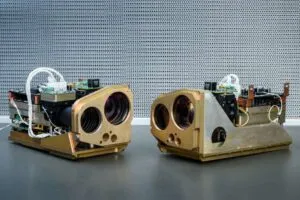Flashlight Laser Crosslink
Dubbed “Flashlight Laser Crosslink” it potentially enables small satellites to operate collaboratively in formations. This could unlock new possibilities for commercial and government missions, says the non-profit organisation, which operates as a federally funded research and development centre.
“In 2018, our engineers successfully demonstrated a one-way laser transmission to a surface station using CubeSats,” said Steve Isakowitz, Aerospace president and CEO. “Now, we’ve advanced that capability by miniaturizing laser and receiver targeting mechanisms to establish a bi-directional link between CubeSats – reducing power demands and costs for future missions.”
“This level of miniaturization presents challenges industry has yet to tackle at scale. Aerospace is bridging that gap, working closely with industry to transition this technology for commercial and government use.”
Data transfer
The demonstration commercial off the shelf parts, reports Aerospace. And a 2.5-unit laser communication terminal to perform bi-directional data transfer between two 6-unit CubeSats. This was at distances of up to 348 miles (560 kilometers).
Data rates of 312.5 megabits per second (Mbps) uncorrected were achieved, and error free transmission at 25 Mbps.
According to Aerospace, independent steering of the transmitter and receiver enable automatic, active alignment, maintaining connectivity over long distances.
Modem speed
The organisation made the analogy that the increase in communication rates is equivalent to going from working dial-up modem speed to high-speed internet.
“The Flashlight Laser Crosslink drastically enhances communication between small satellites, providing them with robust, high-speed data transfer capabilities once limited to larger, more expensive platforms,” added Todd Rose, the mission’s lead.
“By bringing high-speed optical communication to CubeSats, we can empower commercial operators to deploy more efficient systems, bridging the gap between affordability and performance.”
President and CEO
It also announced that Steve Isakowitz will retire as President and CEO in 2026.
He has led The Aerospace Corporation for nearly ten years.
“The past decade has been the most dynamic time in space since the days of Apollo. We have seen the establishment of new organizations like Space Force, an unprecedented increase in launches and the number of satellites on orbit, surging private investment, and the increased application of powerful technologies like AI and machine learning to the space sector,” Isakowitz said.
“Aerospace has been a leader throughout and has continually adapted to stay ahead of the change. We have invested in differentiating technical capabilities that neither the private sector nor the government would pursue, forged new commercial and international partnerships, and drove greater integration across key national security and civil space mission areas.”
During his time as CEO Isakowitz also moved the Aerospace headquarters to the Washington D.C. area.
He previously worked at Virgin Galactic, NASA and the U.S. Department of Energy.
See also: Dev kits for military interconnect are based on VITA technology

